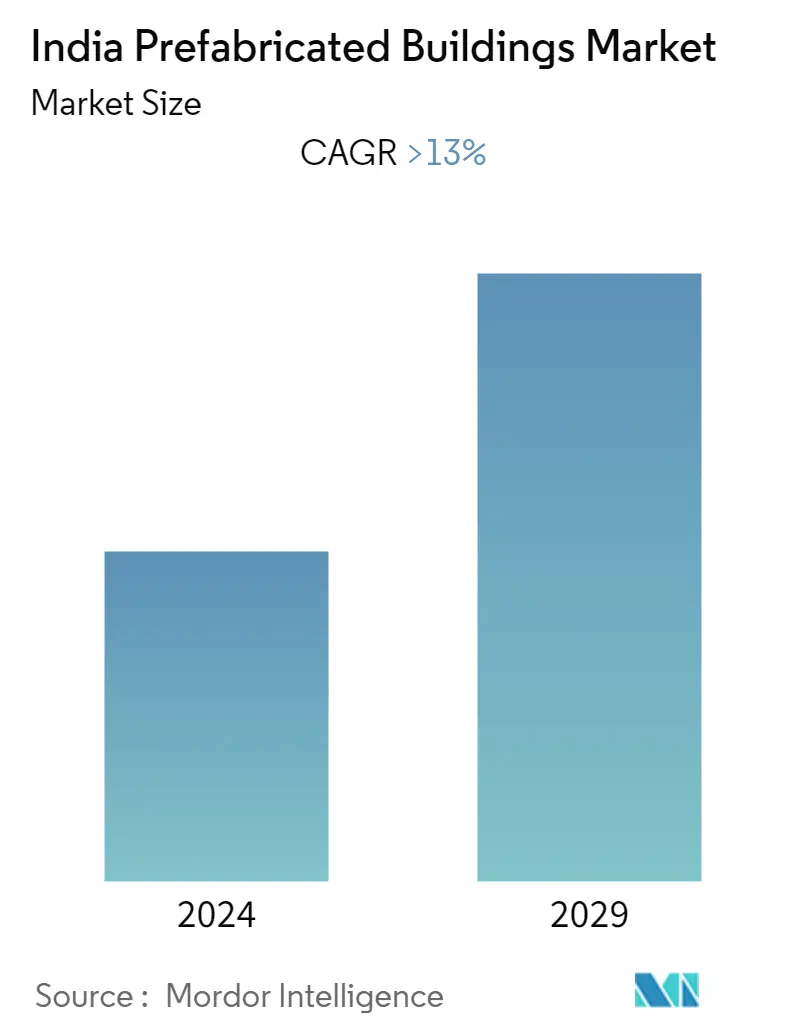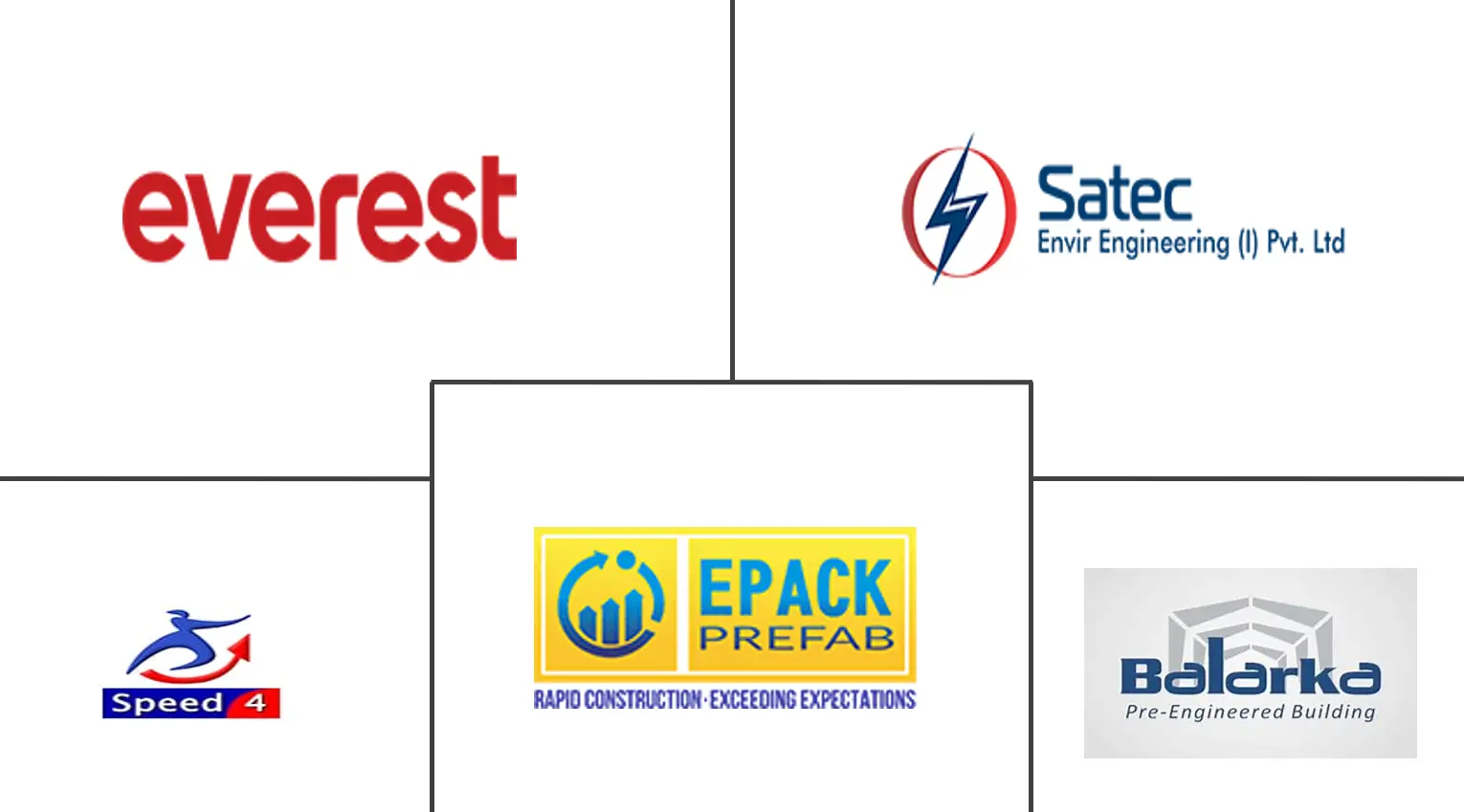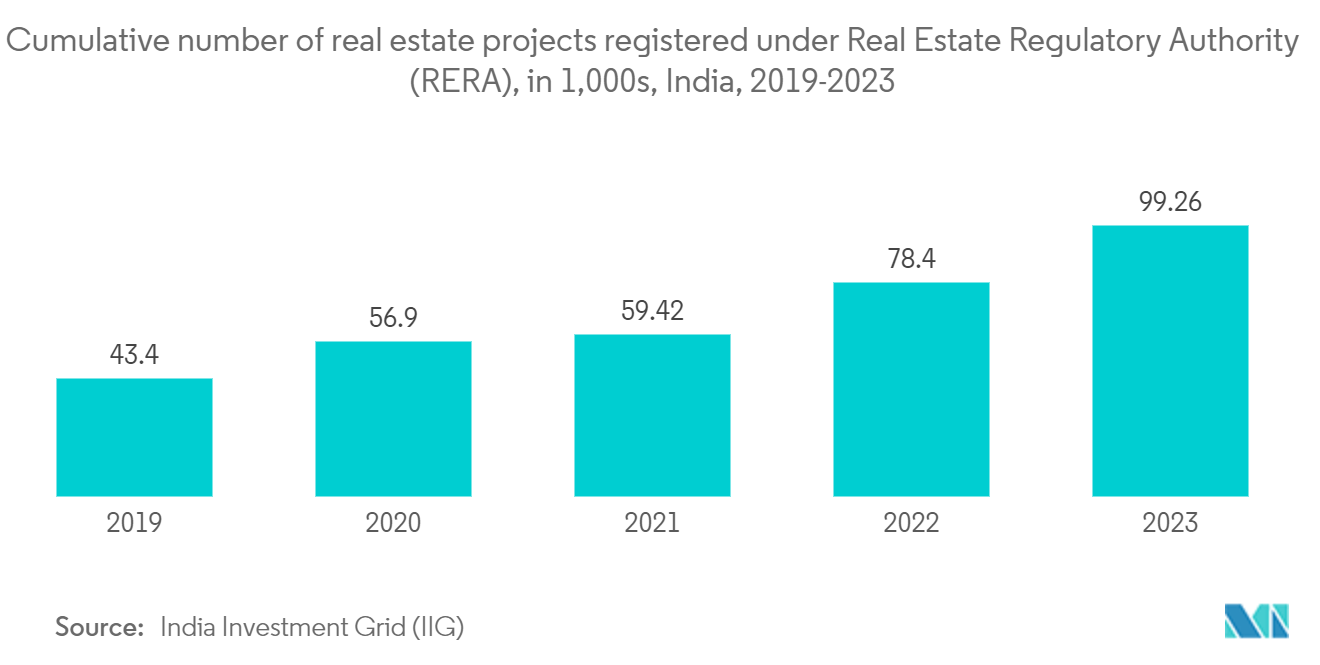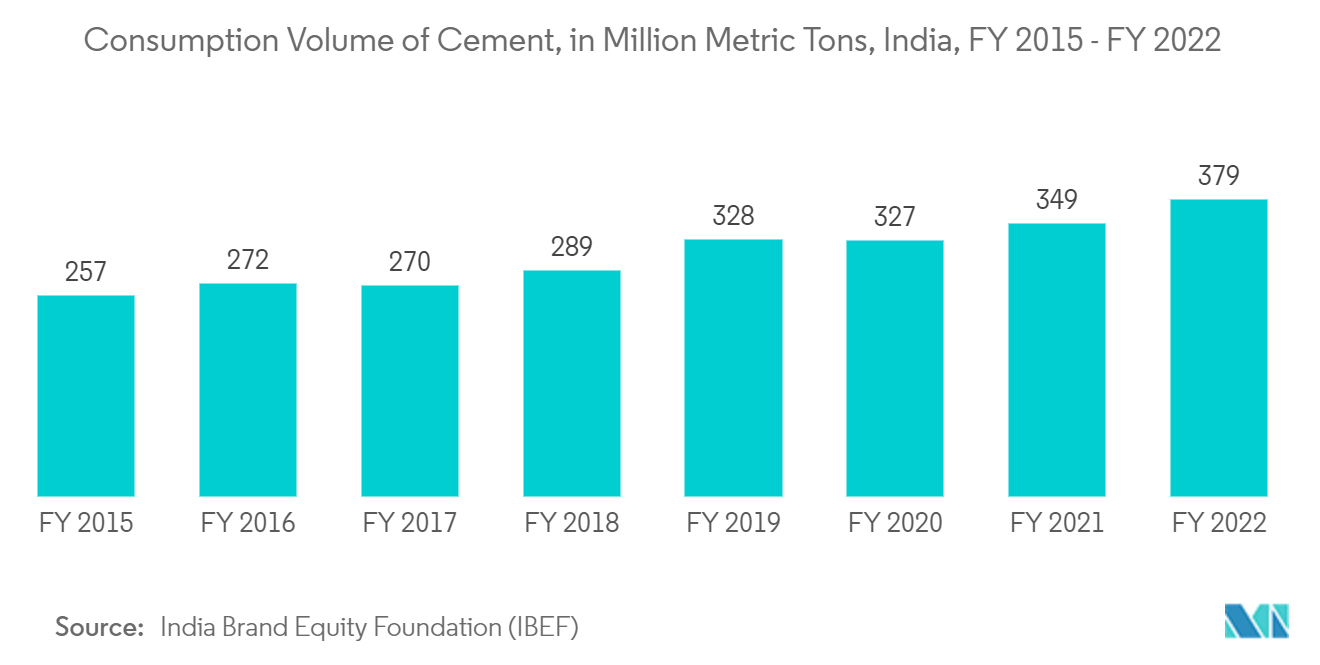India Prefabricated Buildings Market Size

| Study Period | 2020 - 2029 |
| Base Year For Estimation | 2023 |
| Forecast Data Period | 2024 - 2029 |
| Historical Data Period | 2020 - 2022 |
| CAGR | 13.00 % |
| Market Concentration | Medium |
Major Players
*Disclaimer: Major Players sorted in no particular order |
India Prefabricated Buildings Market Analysis
The size of India prefabricated buildings market is USD 2.3 billion in the current year and is anticipated to register a CAGR of over 13% during the forecast period.
- The COVID-19 pandemic had caused massive disruption to construction projects all over India. Manufacturing companies faced a variety of challenges because of the scarcity of raw materials. Furthermore, construction contracts had been halted, resulting in a decrease in the growth of the prefabricated building market.
- The demand for prefabricated building systems had decreased significantly because of the decline in building and construction operations, which led to a significant impact on market growth.
- There is a big opportunity for prefab companies in India, and hundreds of thousands of plants are expected to be required in the future. Over the next few years, India will feature among the fastest-growing countries in terms of construction output, making technology intervention a key component. India is expected to become the third-largest construction market in the world by 2025.
- Prefab construction doesn't require significant investment to maintain it. While some cities, such as Bengaluru, have adopted the concept of prefab, other parts of India continue to face challenges, owing to issues such as government approvals and the lack of suitable land for construction.
India Prefabricated Buildings Market Trends
Government Initiatives in the Infrastructure and Construction Sector to Boost the Industry
In India, the construction industry is divided into two categories: real estate and urban development. Residential, office, retail, hotels, and leisure parks are all included in the Real Estate segment. Water supply, sanitation, urban transportation, schools, and healthcare are all sub-segments of the urban development segment.
By 2025, India's construction industry is expected to be worth USD 1.4 trillion. The urban population will contribute 75% of GDP (up from 63%), and 68 cities will have populations of over 1 million, up from 42 in 2021. India's construction industry is divided into 250 sub-sectors with cross-sectoral connections. By 2030, India's real estate industry is expected to be worth USD 1 trillion, contributing 13% of the country's GDP.
India has a USD 1.4 trillion infrastructure investment budget under National Infrastructure Pipeline (NIP), with 24% going to renewable energy, 19% to roads and highways, 16% to urban infrastructure, and 13% to railways. Between April 2000 and September 2021, Foreign Direct Investment (FDI) in the construction development sector (townships, housing, built-up infrastructure, and construction development projects) and construction (infrastructure) activities totaled USD 26.16 billion and USD 25.95 billion, respectively.
Technology-driven urban planning schemes, such as the revolutionary Smart City Mission (target 100 cities), are expected to improve the quality of life.

Need for Precast Concrete Technology Driving the Market
In recent years, India's urban population grew at a rapid speed, resulting in a scarcity of land, housing, congested transportation, and basic facilities. Precast construction, with proper planning and execution, can meet the needs of the housing mark. Precast construction accounts for only 2% of the Indian construction industry's USD 500 million markets.
Precast systems are mostly used in India for infrastructure projects such as bridges and flyovers. To meet housing demands, the Government of India has approved the use of precast concrete construction methods. According to the Ministry of Housing and Urban Poverty Alleviation, approximately 96% of 18.78 million dwelling units belong to Economically Weaker Section (EWS) and Low Income Group (LIG) households.
The Government of India proposed "Housing for All" as part of the Pradhan Mantri Awash Yojana scheme (PMAY). To meet the PMAY target, precast technology is being used to improve construction quality while also shortening the project's execution time.

India Prefabricated Buildings Industry Overview
The report covers the major players operating in the Indian prefabricated buildings industry. The market is moderately fragmented, and the market is expected to grow during the forecast period due to the increase in prefab construction building investments and upcoming major projects in the country, and other factors that are driving the market.
The major players in the market are Everest Industries Limited, Satec Envir Engineering (India) Private Limited, Epack Prefab, and Speed 4 Prefab Solutions Pvt. Ltd, and Balarka Fabricon Private Limited, among others.
India Prefabricated Buildings Market Leaders
-
Everest Industries Limited
-
Satec Envir Engineering (India) Private Limited
-
Epack Prefab
-
Speed 4 Prefab Solutions Pvt. Ltd
-
Balarka Fabricon Private Limited
*Disclaimer: Major Players sorted in no particular order

India Prefabricated Buildings Market News
- February 2023:Leading building materials manufacturer Everest Industries Ltd. announced that its Board has approved a capital expenditure of INR125 crore for setting up a new manufacturing facility in Andhra Pradesh. The new investment will help the company to enhance its existing capacity of 72,000 MTPA to 1,14,000 MTPA for the Steel Buildings Division. The capital expenditure is likely to be operational by March 31, 2024, and shall be funded through a mix of debt and internal accruals.
- February 2023: EPACK PREFAB, a manufacturer of pre-engineered building solutions, is expanding its manufacturing footprint with an investment of INR 198 crore to set up a new facility spread over 25 acres in Andhra Pradesh. At present, it has two manufacturing plants in Rajasthan and Greater Noida, with a total capacity to produce 1,00,000 metric tonnes of prefabricated material annually, which will increase to 200,000 metric tonnes with the third plant.
India Prefabricated Buildings Market Report - Table of Contents
1. INTRODUCTION
- 1.1 Study Deliverables
- 1.2 Study Assumptions
- 1.3 Scope of the Study
2. RESEARCH METHODOLOGY
- 2.1 Analysis Methodology
- 2.2 Research Phases
3. EXECUTIVE SUMMARY
4. MARKET DYNAMICS AND INSIGHTS
- 4.1 Market Overview
-
4.2 Market Dynamics
- 4.2.1 Drivers
- 4.2.1.1 Government Initiatives for Affordable Housing
- 4.2.1.2 Modular Construction Growth in the Country
- 4.2.2 Restraints
- 4.2.2.1 Transportation Challenges
- 4.2.3 Opportunities
- 4.2.3.1 Rapid Urbanization
- 4.2.3.2 Technological Advancements
- 4.3 Supply Chain / Value Chain Analysis
-
4.4 Industry Attractiveness - Porter's Five Forces Analysis
- 4.4.1 Threat of New Entrants
- 4.4.2 Bargaining Power of Buyers/Consumers
- 4.4.3 Bargaining Power of Suppliers
- 4.4.4 Threat of Substitute Products
- 4.4.5 Intensity of Competitive Rivalry
- 4.5 Technological Trends
- 4.6 Brief on Different Structures Used in the Prefabricated Buildings Industry
- 4.7 Cost Structure Analysis of the Prefabricated Buildings Industry
- 4.8 Impact of COVID-19 on the Market
5. MARKET SEGMENTATION
-
5.1 By Material Type
- 5.1.1 Concrete
- 5.1.2 Glass
- 5.1.3 Metal
- 5.1.4 Timber
- 5.1.5 Other Material Types
-
5.2 By Application
- 5.2.1 Residential
- 5.2.2 Commercial
- 5.2.3 Other Applications (Industrial, Institutional, and Infrastructure)
6. COMPETITIVE LANDSCAPE
- 6.1 Overview (Market Concentration and Major Players)
-
6.2 Company Profiles
- 6.2.1 Everest Industries Limited
- 6.2.2 Satec Envir Engineering (India) Private Limited
- 6.2.3 Epack Prefab
- 6.2.4 Speed 4 Prefab Solutions Pvt. Ltd
- 6.2.5 Balarka Fabricon Private Limited
- 6.2.6 Loom Crafts
- 6.2.7 Angath Exterior & Interior
- 6.2.8 Primex Building Systems
- 6.2.9 Champion Prefabs
- 6.2.10 Interarch Building Products Pvt. Ltd*
- *List Not Exhaustive
7. FUTURE OF THE MARKET
8. DISCLAIMER
9. APPENDIX
- 9.1 Macroeconomic Indicators (GDP Breakdown by Sector, Contribution of Construction to the economy, etc.)
- 9.2 Key Production, Consumption, Exports, and Import Statistics of Construction Materials
India Prefabricated Buildings Industry Segmentation
A prefabricated building, informally a prefab, is a building that is manufactured and constructed using prefabrication. It consists of factory-made components or units transported and assembled on-site to form the complete building.
The Indian prefabricated buildings market is segmented by material type (concrete, glass, metal, timber, and other material types) and by application (residential, commercial, and other applications [industrial, institutional, and infrastructure]). The report offers market size and forecasts for India's prefabricated buildings industry in value (USD) for all the above segments.
| By Material Type | Concrete |
| Glass | |
| Metal | |
| Timber | |
| Other Material Types | |
| By Application | Residential |
| Commercial | |
| Other Applications (Industrial, Institutional, and Infrastructure) |
India Prefabricated Buildings Market Research FAQs
What is the current India Prefabricated Buildings Market size?
The India Prefabricated Buildings Market is projected to register a CAGR of greater than 13% during the forecast period (2024-2029)
Who are the key players in India Prefabricated Buildings Market?
Everest Industries Limited, Satec Envir Engineering (India) Private Limited, Epack Prefab, Speed 4 Prefab Solutions Pvt. Ltd and Balarka Fabricon Private Limited are the major companies operating in the India Prefabricated Buildings Market.
What years does this India Prefabricated Buildings Market cover?
The report covers the India Prefabricated Buildings Market historical market size for years: 2020, 2021, 2022 and 2023. The report also forecasts the India Prefabricated Buildings Market size for years: 2024, 2025, 2026, 2027, 2028 and 2029.
India Prefabricated Buildings Industry Report
Statistics for the 2024 India Prefabricated Buildings market share, size and revenue growth rate, created by Mordor Intelligence™ Industry Reports. India Prefabricated Buildings analysis includes a market forecast outlook to for 2024 to 2029 and historical overview. Get a sample of this industry analysis as a free report PDF download.



